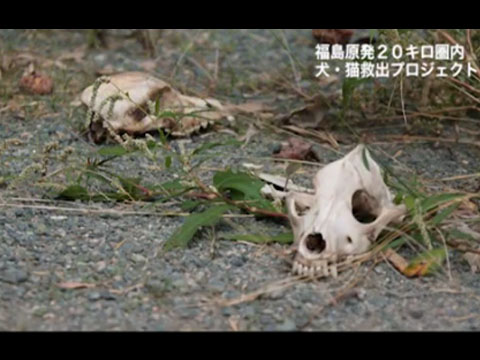站前學英文 | 菁英站前校 【世界新聞專欄:311福島核電 被遺忘的動物們】



IT has long been assumed that filmmakers should tread carefully in the wake of tragedy. Whether confronting war or genocide, a terrorist attack or a natural disaster, the importance of bearing witness bumps up against the danger of trivialization and exploitation. In the annals of catastrophe cinema Japan’s triple disaster has proved to be an unusually accelerated case. Within months of the powerful earthquake and tsunami of March 11, 2011, which killed thousands and caused the reactor meltdowns at the Fukushima Daiichi nuclear plant, there were already enough movies on the subject to constitute an all-but-instant subgenre.
The Berlin Film Festival last month featured three documentaries on the
aftermath, dealing collectively with topics like the complications of the cleanup effort, the plight of evacuees and the resurgent anti-nuclear movement. Japan Society in New York marked the first anniversary with screenings of films like “The Tsunami and the Cherry Blossom,” a short documentary by Lucy Walker that was nominated for an Academy Award, and “Pray for Japan,” which its director, Stu Levy, made while volunteering in the stricken Tohoku region.
The list of documentaries is long and growing: the Fukushima crisis was the subject of a recent “Frontline” episode, and the Japanese broadcaster NHK ran a March 11 program every day in the week leading up to the anniversary. But this new strain of post-traumatic cinema also includes several fiction films, like Masahiro Kobayashi’s “Women on the Edge,” a drama in which three estranged sisters reunite amid the wreckage of their hometown, and “Himizu,” an adaptation of a manga about troubled teenagers that the director, Sion Sono, quickly rewrote to incorporate a backdrop of actual devastation.
The first major attempt at a survey of March 11 cinema came last October at the Yamagata International Documentary Film Festival, situated just on the other side of a mountain range from the Fukushima area. Struck by the number of disaster-theme submissions, Asako Fujioka, director of the festival’s Tokyo office, said she and her colleagues decided to screen everything that came their way. The idea, Ms. Fujioka wrote in an e-mail, was to “eliminate the curatorial hand” and instead present “a makeshift visual archive.” The Yamagata festival showed 29 films about the earthquake’s aftermath in a program called “Cinema With Us.” Some took an oblique approach, like an omnibus project initiated by the filmmaker Naomi Kawase, which included contributions from well-known auteurs, like Apichatpong Weerasethakul of Thailand and Jia Zhangke of China, on the notion of home, but most were on-the-ground dispatches from the hardest-hit areas.


人撤走了,動物們卻只能束手無策地,面對人類的任性
2011年3月14日,福島第一核電廠因為地震而面臨核芯溶解,日本當局緊急撤離核電廠20公里內的居民,但除了人類,福島縣內的各種動物都被留了下來,束手無策地面對人類造成的危機。
3月30日,攝影師太田康介憑著「一定要挺身行動」的信念,帶著貓狗飼料、水和相機衝入福島第一核電廠警戒區,尋找這些被遺忘的動物們。他的想法很簡單,這些動物一直被大部分的人類視為家人,如今突然被捨棄,應該要為她們做一些事情。
太田先生和動物救援義工們將動物們一一送出災區,暫時收養,等原本的主人返回家園時再送還他們。同時他也仔細紀錄這一群動物們——無論是貓、是狗、 是牛、是馬、是豬——的生存現況:許多狗忠實地等待家人返回;許多貓四處覓食,突然開始流浪生涯;許多豬與牛在大街上出現,盡力生存下去、等待家園重建、團聚的一天,但最後竟被撲殺。
太田康介的鏡頭說了一個我們從未注意的故事,讓我們注意到,人類造成的災難是所有的生物一起承擔的後果,特別是這些我們視為家人的動物們。這一張張逃難中的動物照片,一隻隻等待主人現身的小狗與貓咪,讓許多日本人挺身而出加入救援行列,也讓許多動物免於撲殺的命運,讓更多的動物和他們的主人,一起回家。
日本三一一震災引發核輻射外洩危機,災後第三天福島第一核電廠方圓廿公里以內的居民全數撤離,但原本和人一起生活的貓咪、狗狗、豬群、牛馬等動物,卻被拋棄在缺水缺糧的廢墟中,驚恐求生。攝影記者太田康介知情後,趕緊帶著貓狗飼料、水和相機衝進福島,和其他志工組成救援隊伍,將動物送出災區。在救援的三個月內,他以相機記錄災區動物,攝影文集《被遺忘的動物們》近日在台出版。
在他的鏡頭下,一幕幕貓狗驚慌無助、牛馬在無人廄舍裡挨餓的畫面,令人鼻酸。而太田康介不顧危險前往救援動物的愛心,也讓人熱淚盈眶。太田康介寫道:「我能體會在避難時以人類為優先的原則,但接下來應該要立刻對動物伸出援手呀!當我發現真相竟是人類對動物完全棄之不顧時,只覺得不寒而慄。」
他提到,許多狗兒即使家園殘破,仍忠心耿耿不願離去,甚至有隻狗和其他狗打得遍體鱗傷,只為護衛家中雞隻平安活下。當他送走這些守在災區看門的狗時,都會在門上留下電話。有一次一隻小白狗的飼主聯絡上他,相約碰面,小白狗一見到久違的主人好開心,不停搖尾巴,過程十分催淚。
但對人戒心重的貓咪就沒那麼幸運,太田康介很難在災區發現牠們,只能留下飼料乾著急。馬廄中的馬兒總是情緒不穩地蹬著地面。他拍攝到的牛,則是虛弱地跌坐地上哀嚎。去年五月後,政府宣布以安樂死處決這個地區的家畜,有一回,他剛拍下一群豬隻圍著吃他帶來的飼料,隔夜就發現牠們全遭撲殺。吃飼料的豬隻與第二天豬隻屍體成堆的畫面,形成殘酷對比。
「可惡!可惡!人類才是畜生!」太田康介真情流露,時而怒吼時而悲嘆:「枉費你們這麼拚命活下去。大家卻無法因此得救。真的,對不起。」
太田康介把照片貼到部落格上,去年七月底出版,引起政府注意加入救援。他記錄直至攝影集出版前,一共營救安置了五十六隻貓、十三隻狗、十三隻雞,然而只要想到還有許多動物在災區繼續等待,「覺得愧疚到揪心。」

資料來源:
http://www.books.com.tw/exep/prod/booksfile.php?item=0010537213
菁英教育|上海托福培训|上海雅思培训|遊學|托福|多益|雅思|全民英檢|TOEFL|TOEIC|IELTS|GEPT|SAT|上海SAT培训|上海SSAT培训|日本打工度假|日文補習班|菁英排課系統






 留言列表
留言列表
 逛逛菁英其他分校部落格
逛逛菁英其他分校部落格